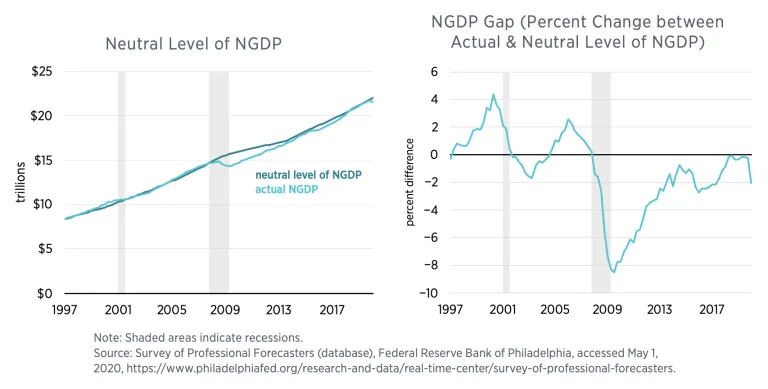- | Monetary Policy Monetary Policy
- | Policy Briefs Policy Briefs
- |
The Neutral Level of NGDP and the NGDP Gap: Q1 2020

The sudden decline in the NGDP gap indicates that the COVID-19 crisis has morphed from a supply shock—a sudden decline in the productive capacity of the US economy—into an even larger spending shock. To be clear, the sharp drop in the NGDP gap does not mean that the Federal Reserve (Fed) has intentionally tightened monetary policy. Instead, it indicates that monetary conditions have continued to tighten despite the Fed’s aggressive response to the crisis.

The neutral level of NGDP was $21.985 trillion in the first quarter of 2020 (see figures above). Actual NGDP came in at $21.538 trillion. NGDP, in other words, was 2.03 percent less than the public expected it to be. By way of comparison, the Congressional Budget Office (CBO) output gap reveals that the real economy was 1.09 percent smaller than its true potential over the same period. Relative to the previous quarter, actual NGDP declined by −0.88 percent (−3.47 percent on annualized basis). The NGDP gap experienced a larger decline than actual NGDP this quarter because the former shows the percent deviation of NGDP from where it was expected to be, whereas the latter shows the percent deviation of NGDP from its value in the previous quarter.
A Closer Look at the NGDP Gap
As noted, the NGDP gap requires an estimate of the neutral level of NGDP. It is estimated by taking an average forecast of NGDP, or equivalent total nominal income, for a given quarter based on forecasts for that period from the preceding 20 quarters. The forecast data used here are taken from the Federal Reserve Bank of Philadelphia’s Survey of Professional Forecasters.
The NDGP gap measures the percent difference between this average forecast and the actual level of NGDP. If the actual level of NGDP is less than the neutral level, then monetary policy is contractionary. If actual NGDP is greater than the neutral level, then monetary policy is expansionary.
The rationale for this understanding is twofold. First, members of the public make many economic decisions, such as whether to take out a mortgage or a car loan, on the basis of forecasts of their nominal income. Similarly, firms may finance with debt and commit to multiyear contracts on plants, raw materials, and labor on the basis of forecasts of their nominal income. Second, the actual realization of nominal incomes may turn out to be very different from what is expected and, as a result, may be disruptive for households and firms that are not be able to quickly adjust their economic plans. These disruptions can be avoided by maintaining total nominal income or NGDP on the growth path expected by the public. In other words, the Fed should aim to close the NGDP gap in order to keep monetary conditions neutral.
For more information on how the NGDP gap is constructed and how it may be used to understand policy, please see “The Stance of Monetary Policy: The NGDP Gap,” a policy brief by David Beckworth. Also, see the NGDP gap web page hosted by the Mercatus Center that provides access to current and vintage data on the NGDP gap.
Key Materials
Click here for the latest NGDP gap data in an interactive chart.
Contact Us
To speak with a scholar or learn more on this topic, visit our contact page.

